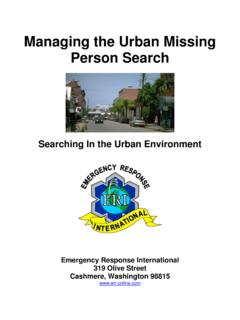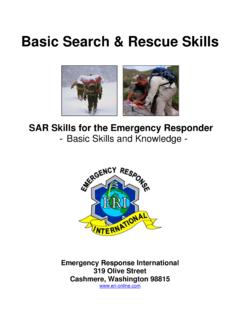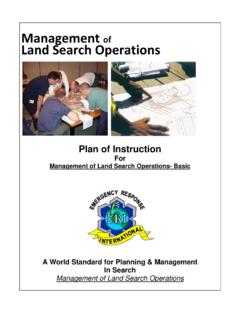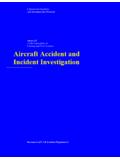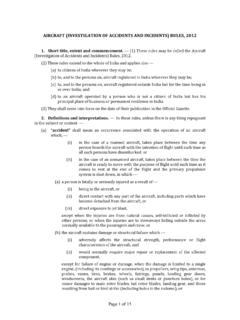Transcription of MODEL SEARCH AND RESCUE PLAN - eri-online.com
1 MODEL SEARCH AND RESCUE plan Written and Edited By Ralph E. Wilfong Published By: Emergency Management Training Specialists P. O. Box 30426 Spokane, Washington 99223-3007 2 Introduction This MODEL SEARCH and RESCUE plan is designed to be used either as a guide in preparing a specific plan for your jurisdiction, or it can be copied verbatim and the items in ( ) filled in as appropriate. This style of SAR plan has been widely adopted in some areas of the country. Ideally, it should be incorporated as part of a jurisdiction s larger Emergency Operations plan (EOP). The jurisdiction s governing body should formally adopt the SAR plan . An alternate method would be to incorporate the plan into the responsible agency s standard operating procedures (SOP). The best written plans are of no value if they are not used.
2 All participating agencies and organizations should be briefed and provided a copy. The SAR plan can be used both as an operational document and as a guidance document. Disclaimer: The MODEL SEARCH and RESCUE plan is not in any way intended to be a training document, nor is it to be substituted for professional, state-of-the-art SEARCH and RESCUE training. SAR is serious business. It is not for the poorly trained or the well meaning. The author gives permission for use of any or all of this document for the stated purpose only. Commercial use or sale is prohibited. Credit is appreciated. Copyright 2004 by Emergency Management Training Specialists 3 SEARCH AND RESCUE plan FOR (NAME OF JURISDICTION) (STATE) ** PURPOSE To establish responsibility, authority, and operational and administrative procedures for SEARCH and RESCUE (SAR) activities within the boundaries of (jurisdiction).
3 OBJECTIVES To describe guidelines for SEARCH and RESCUE incidents that will: -Give the appropriate high priority to the protection of human life. -Locate, provide necessary care, including emergency medical care, and evacuate persons in distress: - using the most effective methods, - with the least elapsed time, - in the safest and most economical way, - and with the least impact on the resources and on the normal, day to day operations of the (jurisdiction). AUTHORITY (Person or agency with responsibility) has the authority and the responsibility for SEARCH and RESCUE within (areas) where (agency) has jurisdiction. SEARCH and RESCUE operations in (jurisdiction) are conducted pursuant to (site state-county-city code section that establishes legal responsibility for SEARCH and RESCUE ) All SEARCH and RESCUE incidents are potentially law enforcement incidents and therefore require immediate law enforcement intervention.
4 4 EMERGENT AUTHORITIES AND RESPONSIBILITIES There may be specific incidents were agencies and organizations outside of (jurisdiction) have a responsibility to prosecute SAR events that may cross jurisdictional lines and include (jurisdiction). Examples are: - Military aircraft incidents - Missions for missing or overdue aircraft, or for an activated Emergency Locator Transmitter (ELT), or Emergency Position Indicating Radio Beacon (EPIRB) - EMS helicopter operations, et al. - SEARCH incidents along the borders of (jurisdiction), including various rivers. PRIORITY OF RESOURCES When it involves a threat to human life, a SEARCH or RESCUE mission will have priority over every other activity, except other, more serious life threatening emergencies. Upon request, every department of (jurisdiction) will provide all equipment, supplies, human resources, and facilities necessary to meet the above stated objectives.
5 PREPAREDNESS (Person or agency) assumes full responsibility for the identification, evaluation, and utilization of SAR resources in (jurisdiction). (Person or agency) will be actively involved in the training and proficiency maintenance of these resources and will develop and maintain alerting and communication procedures that will insure timely notification of and reliable communications with all resources that may be involved in a SAR event. 5 SEARCH AND RESCUE plan FIRST NOTICE Upon notification of a potential SEARCH and RESCUE (SAR) incident , the (jurisdiction) dispatcher will: - Initiate a complaint - Assign field units to investigate - Notify the Supervisor - Notify the following at direction of Officer In-Charge ( ) (List any personnel or resources) - Obtain current weather information, including ground winds, temperature, precipitation and the forecast The supervisor will determine relative urgency of the incident , per Section , and make the following notifications as deemed necessary: - (List personnel) The will be (name) or his or her designee.
6 RELATIVE URGENCY The following guide will help determine the relative urgency of the situation. The lower the priority factor, the more urgent the situation. If any single category is rated 1, the SEARCH would require an emergency response. Subject Profile Priority Factor Number of Subjects - One (alone) .. 1-2 - More than one (unless separation is suspected) .. 2-3 Age - Very young .. 1 - Very old .. 1 - Other .. 2-4 6 Subject Profile Priority Factor Time - Reliable, punctual (being late is out of character) .. 1 - Usually reliable, on time .. 2 - Reliability, punctuality 3 - Completely unreliable .. 4 Circumstances - At risk for any reason .. 1 - Adequate information, low risk .. 2 - Questionable information .. 3 - High probability not in the area .. 4 Subject Experience Profile - Not experienced, does not know the area.
7 1 - Not experienced, knows the area .. 2 - Experienced, does not know the area .. 3 - Experienced, knows the area .. 4 Medical Condition - Know or suspected illness or injury .. 1 - Healthy .. 3 - Known fatality .. 4 Physical Condition - Unfit .. 1 - Fit .. 2 - Very fit .. 3 Clothing - Inadequate .. 1 - Adequate .. 2 - Very good .. 3 Weather - Existing hazardous weather .. 1 - Predicted hazardous weather (8 hours or less) .. 1-2 - Predicted hazardous weather (more than 8 hours) .. 2-3 - No hazardous weather predicted .. 3 7 Subject Profile Priority Factor Terrain and Hazards - Known hazardous terrain or other hazards .. 1 - Few or no hazards .. 2-3 Equipment Profile - Inadequate for the environment .. 1 - Questionable for the environment .. 1-2 - Adequate for the environment.
8 3 NOTE: Elapsed time from when the subject was missing, along with the political sensitivity of the circumstances, will have the effect of increasing the relative urgency. QUICK RESPONSE If the determines that an actual SEARCH operation will be necessary, the following resources should be put on advisory status. - Second shift overhead team - (Other resources) Immediate response resources, if available: - First shift overhead team - Communications equipment - Local air scent or tracking/trailing dog - Visual trackers (Mantrackers) - Locally identified SAR team or SAR team members - Helicopter, if appropriate for situation and weather - RESCUE squad for standby at base Initial actions at the scene: - Identify and secure the point last seen (PLS) - Identify scent article and secure - Initiate the investigation and the collection of pertinent data.
9 Initiate the lost person report form. - Establish incident command post Escalation procedures should be implemented as soon as possible. - Prepare incident Action plan for second shift 8 - Identify needed SEARCH resources and issue advisories - Implement plans to expand the command post activities - Identify and advise necessary support services STRATEGY Consider every incident to potentially involve criminal activity. Initiate the investigation and secure the area accordingly. If the incident is a known RESCUE , determine what resources will be needed to carry out the mission. Establish the probable boundaries of the SEARCH area. Factors to take into consideration include: - Statistical data - History of the area - Clues - Subject profile - Intuition and experience - Natural routes of travel - Analysis of time/distance traveled - Terrain idiosyncrasies, natural barriers to travel TACTICS Initial actions should have three objectives: - Confine the subject(s) travel, prevent enlargement of the SEARCH area.
10 - Effectively use the resources that are immediately available. - Find the subject or any possible clues. Confinement and attraction methods - Road or trail blocks - Camp-ins - Lookouts (survey searches) - Track traps - Road or trail patrols (trail running) - String lines - Noise - Smoke - Lights Generally, available, trained personnel will be dispatched immediately, as hasty teams, to the areas of highest probability to attempt to locate the 9 subject or any clues. Efforts of this type should include: - Following known or suspected routes (route SEARCH ) - Trail running (hasty SEARCH ) - Sign cutting (route and perimeter) - Locale SEARCH of areas of high attraction - Locale SEARCH of especially hazardous areas - Hasty SEARCH along roads - Hasty SEARCH along drainages, streams, river banks and other high probability terrain features - SEARCH of and from ridge tops - The easily forgotten obvious places: restrooms, tents, vehicles, intended destination, etc.
